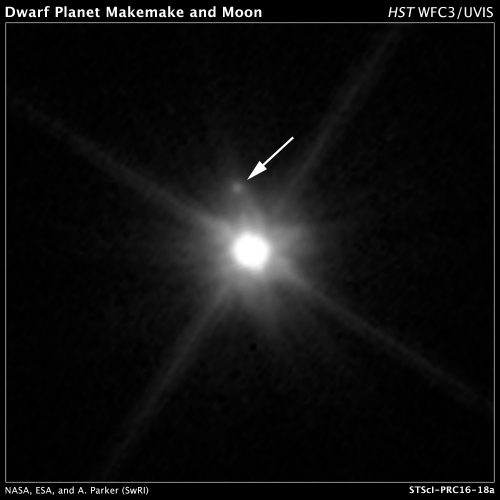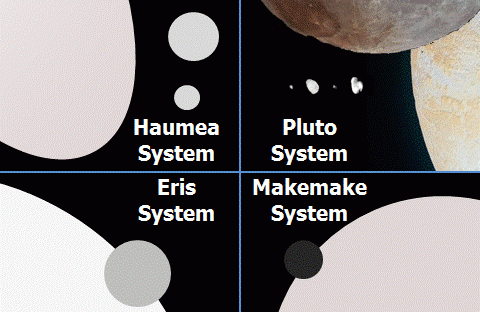Yesterday’s post on the dwarf planet 2007 OR10 brought comments asking why an object this large hasn’t yet been named. Actually it has been, but only briefly. It was Meg Schwamb, then a graduate student of Caltech’s Michael Brown, who discovered 2007 OR10, and Brown quickly gave it the nickname Snow White — as the seventh dwarf Brown’s team had discovered, the name seemed made to order. What derailed the nickname was the realization that 2007 OR10 is not white but red, and as we saw yesterday, one of the darkest known Kuiper Belt objects.
Schwamb herself was quoted in this JPL news release on the matter:
“The names of Pluto-sized bodies each tell a story about the characteristics of their respective objects. In the past, we haven’t known enough about 2007 OR10 to give it a name that would do it justice. I think we’re coming to a point where we can give 2007 OR10 its rightful name.”
We’ll see just what that rightful name is. Remember, too, that 2007 OR10 is now known to be just larger than Makemake, making it about a third smaller than Pluto. As to Makemake itself, a dwarf planet named after a creation deity of the Rapa Nui people of Easter Island, we learned in late April that it has a small, dark moon about 160 kilometers across. That one is designated S/2015 (136472) 1 but is referred to informally as MK 2. The moon is going to be useful as astronomers study the density of Makemake, just as Charon helped us understand Pluto.

Image: This Hubble Space Telescope image reveals the first moon ever discovered around the dwarf planet Makemake. The tiny moon, located just above Makemake in this image, is barely visible because it is almost lost in the glare of the very bright dwarf planet. The moon, nicknamed MK 2, is roughly 160 kilometers wide and orbits about 21,000 kilometers from Makemake. Makemake is 1,300 times brighter than its moon and is also much larger, at 1400 kilometers across. Credit: NASA, ESA, A. Parker and M. Buie (Southwest Research Institute), W. Grundy (Lowell Observatory), and K. Noll (NASA GSFC).
On to Haumea
These are good times for those of us interested in small worlds at the edge of the Solar System, especially when you factor in the continuing dataflow from New Horizons. And now we have new analysis of the dwarf planet I would most like to get an orbiter around, the ever intriguing Haumea. Its unusual shape — Haumea is a flattened ellipsoid with its longest axis about 2000 kilometers across — is likely the result of an ancient collision. It’s also highly reflective, with a surface evidently covered with crystalline water ice (cryovolcanism?).
Rotating every 3.9 hours, which is faster than any other large object in the system, Haumea was discovered to have a dark spot on its otherwise bright surface in 2009, an area evidently richer in minerals and organic compounds than surrounding areas. The dwarf planet also has two moons, known as Hi?iaka (the outer satellite) and Namaka (the inner), and is evidently the parent body of a family of icy fragments with similar albedo now orbiting the Sun. Just how the moons formed and what we can learn about the composition of Haumea itself make this an intriguing object for those trying to piece together the early history of the outer system.
Both Pluto and Haumea have multiple moons, while Eris and Makemake have a single moon each. But what Haumea seems to lack in comparison to Pluto are small icy moons like Pluto’s Nix, Hydra, Kerberos and Styx. In a new paper, Luke Burkhart (Harvard-Smithsonian CfA) and colleagues look at Haumea via Hubble data taken in July of 2010, in a search for additional moons that came up dry. The work sets strong limits on the size and location of any possible undiscovered moons, with implications for the formation of the satellite system.
From the paper:
As the properties of the dwarf planet satellite systems differ significantly, it was not anticipated that Pluto’s small satellites would necessarily find counterparts around Haumea, though it seems that Makemake may have a satellite of similar size (Parker et al. 2016). Our null result affirms that, for the time being, Pluto is the only known KBO with a retinue of small satellites, though such could have been detected or nearly detected around all four dwarf planets. This implies that the satellite systems may result from somewhat different formation pathways, although all the dwarf planet satellites are probably connected with a collisional formation. Pluto’s small satellite system may be connected with Charon since, from a dynamical perspective, the other dwarf planet satellites are more like small moons compared to the near-equal-sized Pluto-Charon binary.
Darin Raggozine (Florida Institute of Technology) says that despite some similarities, the satellite systems we’ve observed around the outer dwarf planets must have had different formation processes. Both Pluto and Haumea have planetary scientists searching for answers. “There is no self-consistent formation hypothesis for either set of satellites,” adds Raggozine in this FIT news release.
We also learn that moons the size of Pluto’s Nix and Hydra would have been detected if present at Makemake, and in fact would be near the detection threshold even for distant Eris. The paper notes that improving these detection limits would take extensive observations, a task perhaps suited to the James Webb Space Telescope. What we do know is that no satellites larger than about 8 kilometers in radius are found between 10,000 and 350,000 kilometers of Haumea. This is the region which, around Pluto, contains Charon and the four smaller satellites.

Image: A comparison of the four icy dwarf planets and their moons, with all objects to scale. These large bodies in the outer Solar System share many similarities, but one difference is that only Pluto has a collection of tiny moons (shown near the center). Research from Luke Burkhart at Yale University, Darin Ragozzine at Florida Institute of Technology and Michael Brown at Caltech found that Haumea, a dwarf planet on the edge of our Solar System, doesn’t have the same kind of moons as its well-known cousin Pluto. Credit: D. Ragozzine (FIT)/NASA/JHU/SwRI.
The paper is Burkhart et al., “A Deep Search for Additional Satellites around the Dwarf Planet Haumea” (preprint).



In the Pluto system the satilites look like Pluto and Charon have had a fight and one of them has lost some teeth. In fact it may not be far from the truth as they are more likely chips off the old blocks.
We are looking into making totally solid state semiconductor chip spaceprobes which we can launch on accurate trajectories at any velocity we please between 0 and 0.2c. I wonder what the maximum deceleration (read: crash velocity) one of them could take is. If only one in a thousand survived at some velocity, we could just launch a thousand if the unit production cost is loose change. Perhaps we could get some useful science mileage from crashing postage stamp probes into the outer dwarf worlds. The higher velocities likely achievable would reduce mission times dramatically. I imagine it wouldn’t be too much of a stretch to put some sort of spectroscopic stuff on a chip.
Seeing as how dozens of gram-scale objects can be launched per day, and seeing as how it takes less than 4 hours to reach Jupiter, why not remote drill Europa with such a particle beam?
A 1 gm probe at 0.2c would release energy on impact of the order of 1 kiloton TNT. So probes flying behind could do some pretty amazing spectrographic analysis of the interiors of worlds.
What would such an energy release do for investigating the composition of the subsurfaces of worlds like Europa? Could several be sent in serially to punch a really deep hole, perhaps to the ocean below?
While Lubin suggested using the phased laser arrays to directly vaporize asteroids, would impacts work better on some bodies, such a iron and stony-iron type asteroids?
One thing we might do with kiloton postage stamps is fire some at planet nine, should it be discovered. If they find this as far out from the sun as they are predicting it will be very, very dark and an impacting probe would provide useful illumination for other probes further back in the caravan to snap a decent photo. If a second probe impacted after the first, the back-reflection off the debris cloud kicked up by the first would give better, more wide ranging illumination.
Robert, on a lighthearted note and with the ‘zoo-hypothesis’ in mind, you may be declaring interstellar-war by launching an attack on the zoo-keepers base on Planet Nine :D
Oooops! My bad! :D
Perhaps the huge energies of this type of impactor(s) would negate planetary-protection concerns… perhaps?… (a steerable phased array may be less troublesome when creating bore-holes… for rotating bodies anyway).
I wonder if we could create a reasonably tight swarm of mirrored disk craft with attitude control and relative position control(perhaps by magnets) whether we might program the swarm to organise into a rough and ready Fresnel type lens (paired reflections from the front of one mirror onto the back of another at a slightly different angle) that could provide some focusing of the beam at a large distance. Someone would have to do the proper math to figure out if it could provide a meaningful level of focusing. If a goer, it would also provide some beam steering at a distance, for planet drilling, space invader repelling, etc.
The impact would create a hole but there is simply not enough energy to bore through an ice shell like Europa’s, but as you say it will remove a significant amount of material to allow examination of underlying strata, somewhat modified by the heat though. Now to punch through 30 miles of ice would require trillions of megatons, best to drop a probe down a crack and let it melt its way down at the same time as examining the past history of the world in the layered morphology.
Agreed. But we can’t bore down through the ice with a radioactive slug just 1 gm in mass. It will have to be a lot bigger. So a heavy slug, propelled by a large sail with a relatively slow velocity. It might even need to slow further by swinging around Jupiter and being decelerated at that point, perhaps using a number of orbits.
Another thought about the Jupiter system in particular. A postage stamp probe with a circular mirror moving at high speed (not necessarily relativistic though – not needed for in system work) would be cutting through a lot of magnetic field lines very quickly. If there was a loop of wire around the mirror it might provide a substantial power supply (relative to a silicon chip) to do something useful with during a fly through mission.
Jupiter’s powerful magnetic field will deflect the beam, it is very strong and again the rotation is a problem.
Haumea was discovered to have a dark spot on its otherwise bright surface.
So that is where the monolith is now. Moved itself from Iapetus to mark the new outer edge of human exploration.
Haumea is thought to be a Jacobi ellipsoid (the equilibrium surface for an extremely fast rotator) not a contact binary or a collisional remnant. See http://arxiv.org/abs/1402.4456
That would explain it. I thought that an object this large could not possibly have a non-equilibrium shape, and was perplexed by the claim that this one did.
All these worlds/systems seem unique and deserve at least a flyby, but of course under current technological and budget conditions it will never happen. Haumea seems especially weird with its triaxial ellipsoidal shape. We need an order of magnitude drop in prices to send a swarm of ultralight flyby probes to every TNO that has obtained hydrostatic equilibrium. I hope something like what Robert proposes comes to pass!
P